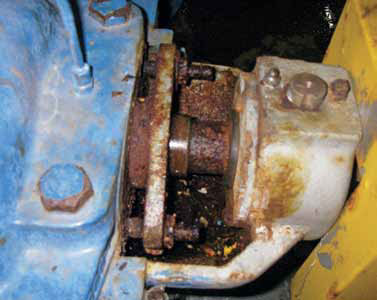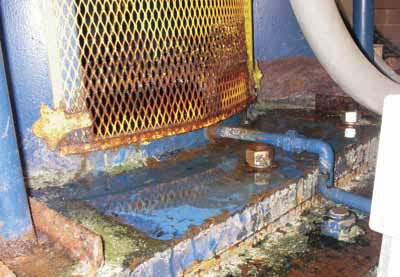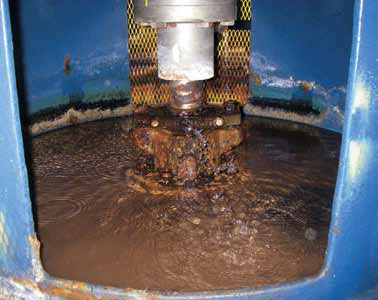Knowing the basics of pump repair can simplify preventive maintenance.
Technical manuals with specifications like tolerance and pressures are important tools for troubleshooting hard-to-fix problems. General shop tools and a range of wrenches, sockets and screwdrivers are also helpful in pump repair. Packing pullers, grease guns and the proper lubricants save time and money.
In addition to these physical tools, most pump repairs require that the user have a certain depth of knowledge when inspecting or servicing. Problems with pumps normally have an underlying cause of failure, which often extends beyond the failed item. The maintenance methods described below form some of the basic knowledge needed for servicing.
Packing
When checking the packing gland, look for excessive leakage and repack if needed. When leakage is excessive, the maintenance operator should tighten the packing gland. Keep in mind the leakage should not be completely stopped because water serves as the coolant for the packing in the stuffing box.
 |
| Improperly adjusted packing gland with no leak off |
Packing around the shaft should be tightened just enough to allow about 20 drops per minute. If the follower cannot be properly adjusted anymore, the pump needs to be repacked with the proper packing.
When selecting packing, keep in mind the pressure and shaft speed.
Repacking a Pump
When repacking a pump, ensure that the driver and pump have been safely isolated and that all safety precautions are followed.
New packing should never be added on top of old packing. Start by removing all packing and the lantern ring. Once you have removed the old packing, clean out the stuffing box and inspect the shaft sleeve for unusual wear. Proper tools should be used—never use a screwdriver. Using the wrong tools may damage the stuffing box or shaft sleeve.
New packing should fit around the shaft with no gaps at the joints. Place the joint of the second piece of packing 90 deg away from the joint of the first piece of packing. Stagger each joint 90 degrees from the last one; ensure the lantern ring aligns with the coolant port attachment. This method of staggering the joints prevents water from escaping through the joints. Follow this process until the stuffing box is full.
The packing gland should be placed on top of the packing. Tighten down the followers. Adjust the followers one flat or ¾ of a turn every 30 minutes or until the leakage is controlled. Feel the packing gland (be careful of the rotating shaft) to see if the packing gland is too hot or uneven, which will result in damage to the pump shaft.
 |
| Excessive leaking at packing gland |
Bearings
Overheated bearings are caused by friction, which can result from a lack of lubrication. When inspecting a bearing, all fittings and grease cups should be cleaned before greasing to remove any dirt. Dirt particles can cause bearing contamination and premature bearing failure.
Lubrication of a bearing should follow the manufacturer's recommendations. Additional grease above the recommended amount may cause the bearings to overheat.
When you start greasing a bearing, remove all relief plugs. Removing the plugs allows the old grease to pump out as the new grease is pumped into the housing. Conduct an inspection of the old grease and look for metal particles or metal shaving. Any particles found in the old grease indicate wear, which needs to be addressed.
Couplings
Like bearings, couplings require lubrication. When performing maintenance on couplings, ensure safety procedures are followed.
When preventive maintenance is performed, remove the coupling guard to expose the flexible grid. Remove the grid, and inspect it for wear. Whenever metal particles are found, check for misalignment. Immediately inspect the grease for any metal particles.
Once it is determined that the coupling can be reused or if a new one is needed, clean all parts to ensure no dirt or grit is on the grid or coupling halves. To reassemble, the grid goes on the drive end of the motor and the driven end of the pump. Install the couplings bolt in place and remove the relief plug. New grease should be pumped into the grease fitting until it is expelled from the relief port. Take care not to over-grease the coupling since it will damage the rubber seal on the coupling halves.
Inspection
Inspections play a vital role in a preventive maintenance program. Inspections are conducted to determine the operation condition of pumps and associated equipment and help predict what corrective or preventive maintenance will be needed to prevent serious problems.
Inspection cannot be overlooked or falsified. It should be routine—daily or even weekly.
During a visual inspection, the operator should look for clogged drain lines, excessive leaking from packing glands, overheated bearings or bearings operating at higher than normal temperatures.
 |
| Improperly adjusted packing gland with no leak off |
Listen for any unusual noise or vibration or anything uncommon when conducting a visual inspection. Vibration is associated with pump operation and must be addressed immediately before serious problems occur and the pump ultimately fails. Noisy bearings can be caused by vibration from loose bearings on the shaft or a failed shaft coupling.
An inspection checklist is a great way to ensure nothing is overlooked. I highly recommend that maintenance operators carry a copy of past inspection data to compare new findings. This will allow maintenance operators to detect any new problems and identify trends among the normal operations.
Operation condition may not be ideal to start and stop equipment. However, an inspection must be conducted before the next inspection cycle.
After inspections, maintenance operators must sit down with supervisors to discuss any problems found.
Supervisors must be able to prioritize concern and schedule preventive and corrective maintenance.
Although problems vary, corrective maintenance can be minimized with proper operation and preventive maintenance procedures.
Basics Checklist
- Packing glands must not be allowed to leak excessively and should be corrected.
- Bearings must have the proper amount of grease and fit clean to prevent premature failure.
- Vibration must be addressed, or serious pump failure will result.
- Maintenance operators must document all finds and express their concerns so the proper corrective or preventive maintenance action will occur.
Pumps & Systems, September 2010


